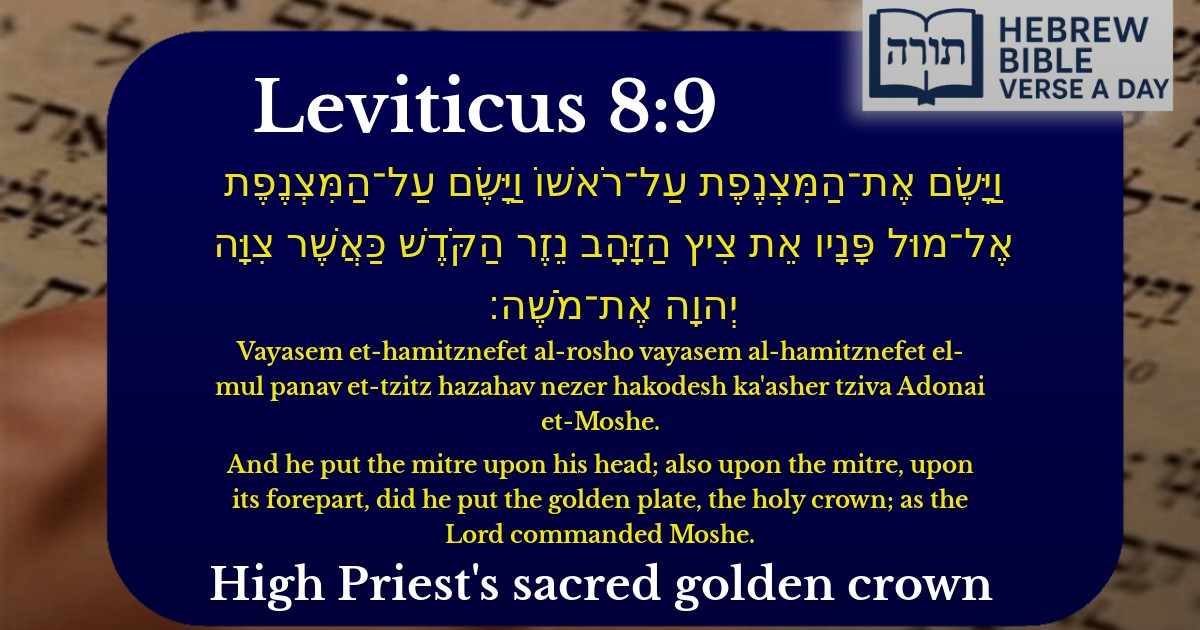Join Our Newsletter To Be Informed When New Videos Are Posted
Join the thousands of fellow Studends who rely on our videos to learn how to read the bible in Hebrew for free!
Hebrew Text
וַיָּשֶׂם אֶת־הַמִּצְנֶפֶת עַל־רֹאשׁוֹ וַיָּשֶׂם עַל־הַמִּצְנֶפֶת אֶל־מוּל פָּנָיו אֵת צִיץ הַזָּהָב נֵזֶר הַקֹּדֶשׁ כַּאֲשֶׁר צִוָּה יְהוָה אֶת־מֹשֶׁה׃
English Translation
And he put the mitre upon his head; also upon the mitre, upon its forepart, did he put the golden plate, the holy crown; as the Lord commanded Moshe.
Transliteration
Vayasem et-hamitznefet al-rosho vayasem al-hamitznefet el-mul panav et-tzitz hazahav nezer hakodesh ka'asher tziva Adonai et-Moshe.
Hebrew Leining Text
וַיָּ֥שֶׂם אֶת־הַמִּצְנֶ֖פֶת עַל־רֹאשׁ֑וֹ וַיָּ֨שֶׂם עַֽל־הַמִּצְנֶ֜פֶת אֶל־מ֣וּל פָּנָ֗יו אֵ֣ת צִ֤יץ הַזָּהָב֙ נֵ֣זֶר הַקֹּ֔דֶשׁ כַּאֲשֶׁ֛ר צִוָּ֥ה יְהֹוָ֖ה אֶת־מֹשֶֽׁה׃
וַיָּ֥שֶׂם אֶת־הַמִּצְנֶ֖פֶת עַל־רֹאשׁ֑וֹ וַיָּ֨שֶׂם עַֽל־הַמִּצְנֶ֜פֶת אֶל־מ֣וּל פָּנָ֗יו אֵ֣ת צִ֤יץ הַזָּהָב֙ נֵ֣זֶר הַקֹּ֔דֶשׁ כַּאֲשֶׁ֛ר צִוָּ֥ה יְהֹוָ֖ה אֶת־מֹשֶֽׁה׃
🎵 Listen to leining
Parasha Commentary
📚 Talmud Citations
This verse is quoted in the Talmud.
📖 Zevachim 19a
The verse is referenced in a discussion about the proper placement of the priestly garments, particularly the mitre and the golden plate, as commanded in the Torah.
📖 Menachot 37b
The verse is cited in a discussion about the details of the priestly garments and the significance of the golden plate (tzitz) as part of the high priest's attire.


The Placement of the Mitre and the Golden Plate
The verse describes Aharon the Kohen Gadol (High Priest) placing the mitznefet (mitre) on his head and affixing the tzitz ha-zahav (golden plate) upon it. According to Rashi (Shemot 28:37), the mitznefet was a turban-like head covering, while the tzitz was a thin golden plate inscribed with the words "Kodesh LaHashem" (Holy to the Lord). The placement of these items was a precise fulfillment of Hashem's commandment to Moshe.
The Significance of the Tzitz
The tzitz served as a constant reminder of the sanctity of the Kohen Gadol's service. The Talmud (Zevachim 88b) explains that the tzitz atoned for arrogance and improper thoughts during the sacrificial service. Rambam (Hilchos Klei HaMikdash 9:1) emphasizes that the tzitz was positioned on the forehead, facing outward, to symbolize that the Kohen Gadol carried the sanctity of the Jewish people before Hashem at all times.
The Order of Placement
The verse specifies that the tzitz was placed "upon the mitre, upon its forepart", indicating a deliberate sequence. The Midrash (Sifra Tzav, Mechilta d'Miluim) teaches that each garment of the Kohen Gadol had its own unique spiritual purpose, and their proper arrangement was essential for the divine service. The positioning of the tzitz above the mitznefet highlights its role as the "crown of holiness" (nezer ha-kodesh), representing the pinnacle of the Kohen Gadol's sacred duties.
Fulfillment of Divine Command
The concluding phrase, "as the Lord commanded Moshe", underscores the importance of exact adherence to halachic details. The Sforno (Shemot 39:31) notes that this refrain appears repeatedly in the description of the Mishkan's construction to emphasize that every detail was executed precisely according to divine instruction, without deviation. This principle applies not only to the Kohen Gadol's vestments but to all mitzvos, teaching us the value of meticulous observance.